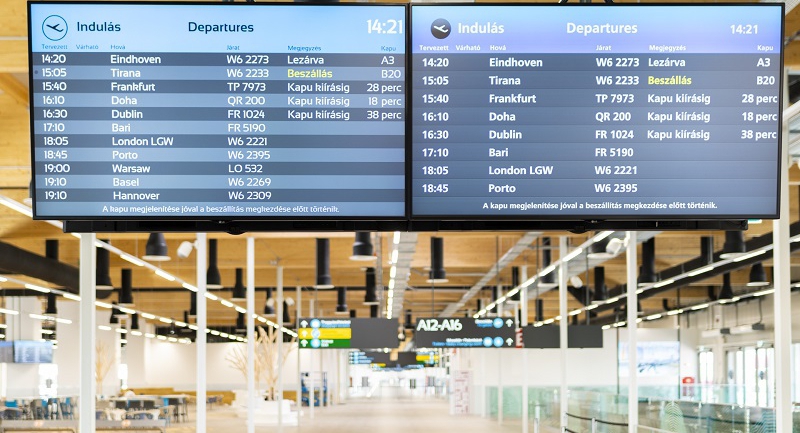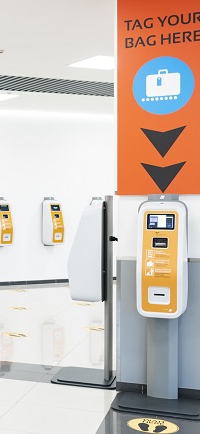
Best of Budapest & Hungary
Measure of Quality
167 million euros for development in two years at Budapest Airport
During the past two years, Budapest Airport implemented 167 million euros worth of investments at the airport, whereby the regional significance of BUD has been greatly enhanced, while maintaining a high level of safety and security. The large projects and other background developments, built around infrastructure, capacity enhancement and digitization, generated a tangible increase in the passenger experience, which is confirmed by research and passenger feedback.
Not even the coronavirus pandemic was able to halt developments; over the past year, Budapest Airport implemented numerous investments – the airport was renewed to a value of 74 million euros in 2020 alone. In several cases, it brought forward projects which were easier to implement during the period of low traffic.
The three big tickets: the BUD Cargo City, Pier 1 and the baggage sorting facility
At the end of 2019, Budapest Airport handed over the air cargo handling facility called the BUD Cargo City, with the first dedicated cargo flight taking off from here in January 2020. The operator had reason to celebrate; while it provides a professional environment and competitiveness for the air freight industry, the new air cargo complex could bring a regional leading role in the sector for Budapest Airport and the Hungarian economy. Following opening, the airport’s air cargo handling capacity increased to 250 000 tons per year; preparations for the second phase of the investment, which cost 50 million euros so far, will begin already in 2021. Just a few months after completing Pier B, Budapest Airport commenced the construction of Pier 1, adjoining Terminal 2A. Execution was finalized in record time; the new building section, a 33 million euro investment, increases the capacity of Terminal 2A by several thousand square meters, satisfies all needs and ensures that passengers can wait in convenience. Pier 1 is connected to Terminal 2A with an air-conditioned corridor, equipped with escalators and elevators. The spacious pier is able to accommodate up to 5000 passengers at a time, with 2500 seats ensuring that they can wait for their flights in comfort. At the end of September 2020, the construction of the external baggage sorting hall and the related baggage system were completed. Thanks to the new facility and the state-of-the-art machinery, the capacity of the entire baggage handling system has increased by 50%, whereby bags travel over a total of 2.8 kilometers from the check-in counters, through the screening system to the sorting hall. The two-lane roundabout leading to Terminal 2 was also completed in 2020, whereby road access to the airport has become safer and faster. The roundabout was implemented with the aim to effectively serve both the increased future passenger traffic of Terminal 2 and freight vehicles turning off towards the Cargo City.
Capacity expansion, creating a new environment
Budapest Airport handed over two new passenger security screening lanes last June, increasing the number of screening lanes available in the terminals to 18 in total. Waiting time before security screening can thus remain below 15 minutes even in the busiest periods. The new lanes are equipped with an automated system enabling the introduction of the most advanced method of screening cabin baggage, called remote screening. During the past years, bathroom capacity at the airport was increased by 70%; there are now 28 restroom blocks available at the terminals. The operator also installed 11 new drinking fountains; besides enhancing passenger convenience, taking environmental considerations into account, by reducing the number of plastic bottles purchased. The airport operator also used the period of low traffic to refurbish the curbside in front of the terminals, Premium Parking and the walkway between the car parks and the terminal. The floor tiles in the check-in hall of Terminal 2A have been replaced. The multilingual information signs facilitating orientation have been renewed and the elevators at Terminal 2A have been replaced.
Digital developments
The first in the line of digital developments enhancing the travel process was the replacement of the flight information boards at the terminals. Passengers can now view flight information on super-wide and ultra-sharp 4K resolution passenger information panels, which also display the walking distance to the gates or the estimated waiting time at passenger security screening, for example. An important step forward that is not so apparent to passengers was the replacement of the virtual flight information system, which is provided from 2020 with the latest software currently available. In the second half of 2019, Budapest Airport and the National Police Command installed a total of 12 automated passport control gates in the terminals, and automated boarding gates were also implemented at Terminal 2A. Thanks to the advancing trends of automation, sixteen bag tag printer kiosks are now available in the check-in hall of Terminal 2B, which make it possible for passengers to perform baggage check-in on their own quickly and contactlessly, when flying with airlines who have joined the system. In addition to the new lanes, the process of passenger security screening has also been accelerated by a more advanced screening system; larger electronic devices can now remain inside hand baggage.
Sustainability, other background developments
The runways at the airport undergo regular maintenance every year. The water drainage system of runway II, the pavement markings and the asphalt shoulder of the adjoining taxiway Y were renovated in the fall of 2020, with navigation and lighting systems also modernized. In December, Budapest Airport handed over the refurbished taxiway U, which was completed in an environmentally friendly manner, recycling the old concrete structure. The heating center of the airport was also modernized; by applying heat insulation to more than 2500 fittings providing heating for office, warehouse and hangar buildings, the airport saves 170000 cubic meters of natural gas and 340 tons of carbon dioxide emissions a year, also significantly reducing environmental burdens. Budapest Airport also supports the reduction of environmental impacts by developing e-mobility and encouraging the use of electric vehicles; 76 ground handling vehicles as well as 10 fleet and manager cars were recently replaced with electric or hybrid models upon the operator’s initiative, saving 140 000 liters of fuel and 350 tons of carbon dioxide a year in total. Budapest Airport has installed 42 electric vehicle chargers so far, and, in addition to improving public transport, it is constructing a bicycle road to the terminal. The operator also fully supports the establishment of the railway connection between the city center and Terminal 2. The coronavirus pandemic also necessitated some new features in 2020; Budapest Airport has installed Plexiglas screens between passengers and staff, wherever this was feasible, has placed hand sanitizer dispensers throughout the building and increased the number of automatic baggage drop-off kiosks. A coronavirus test center opened on the arrivals level of Terminal 2B in December, offering both PCR and rapid antigen tests.
Positive feedback, more satisfied passengers
Budapest Airport’s 167 million euro developments have been confirmed by passengers as well. According to a survey conducted by an independent market research agency, the majority of Hungarians consider Ferenc Liszt International Airport reliable, modern, well-organized and continuously developing. Most respondents highlighted the high service quality, the professional work of staff and the clean and safe environment of the terminals as positives, whereby they consider Budapest Airport to be of European standard and a worthy gateway for the country. The international passenger satisfaction survey (ASQ) also supports these results; the general level of satisfaction reached 4 points, which is excellent, even by international comparison. Dr. Rolf Schnitzler, the CEO of Budapest Airport highlighted in connection with the developments: “We have been named the best airport in the region seven times in seven years, and we can further strengthen our position in the region and in Europe with our developments. Additionally, we must also comply with the new challenges brought for airports by the coronavirus pandemic. A calculable journey and safety will be even more important in aviation going forward; our task is to provide these for our passengers under all circumstances.”





